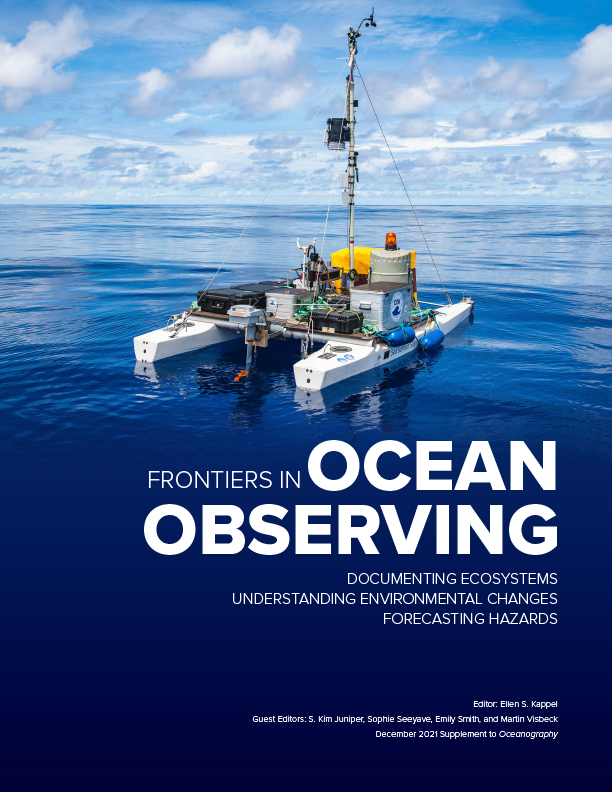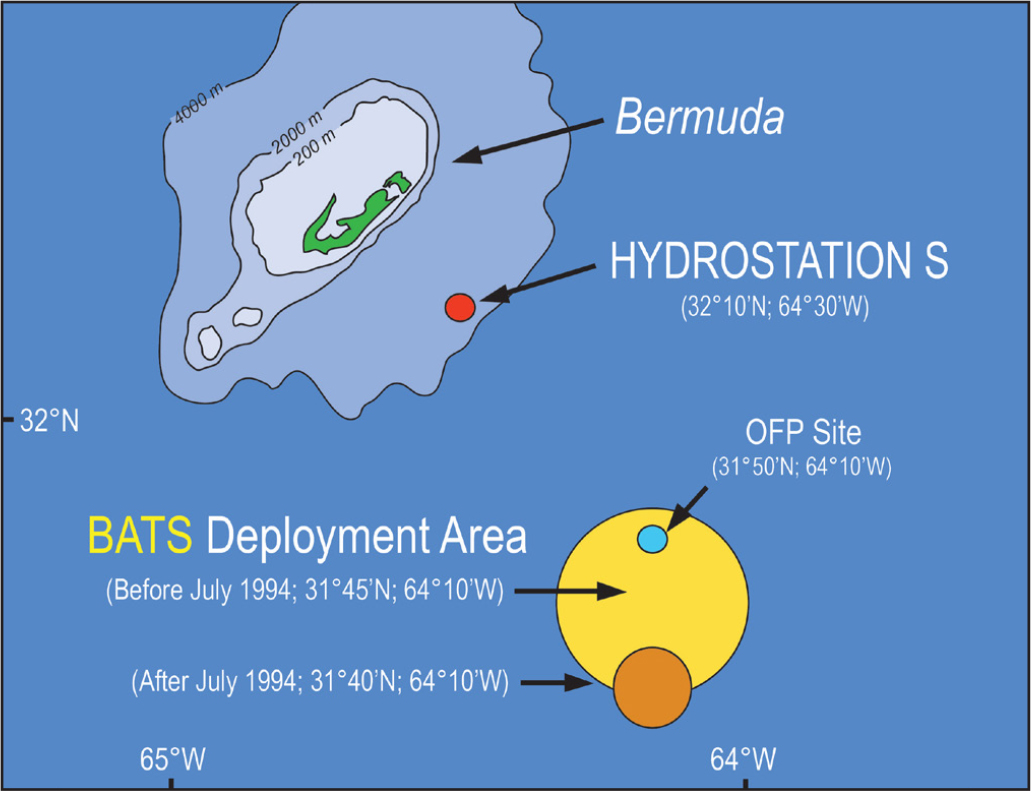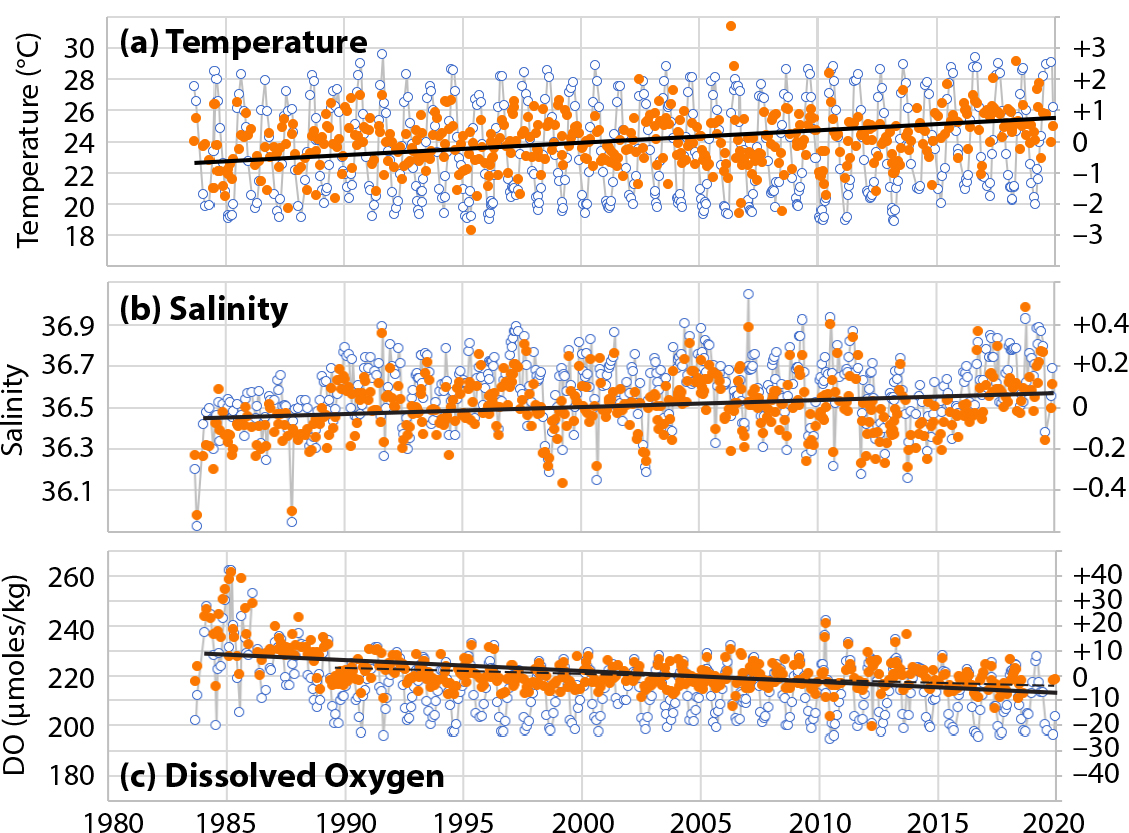Full Text
Since the first samples drawn from the Sargasso Sea were analyzed nearly 70 years ago, waters in this subtropical region of the North Atlantic Ocean have grown warmer (+1.2°C) and saltier (+0.11), lost oxygen (8% over past 40 years), and gained anthropogenic carbon dioxide (CO2; 72% increase), and in the recent decade, these changes have accelerated (Bates and Johnson, 2020). We present the findings from shipboard observations in the deep Sargasso Sea at Hydrostation S and the Bermuda Atlantic Time Series, two time-series stations maintained by the Bermuda Institute of Ocean Sciences, which is situated near the center of the North Atlantic Ocean subtropical gyre. Oceanographic data collected at these two stations provide critical information about ocean changes taking place and what these changes might mean to the future of our planet.
Hydrostation S
Following the Second World War, Henry Stommel, a pioneering oceanographer from the Woods Hole Oceanographic Institution, established Hydrostation “S,” located approximately 25 km southeast of Bermuda (Figure 1), as a place for collecting sustained observations of the deep sea. Biweekly collection of core water column measurements (temperature, salinity, and dissolved oxygen from the surface to 3,400 m depth; to 2,600 m prior to 2000) at Hydrostation S began in 1954. To date, more than 1,417 cruises have been undertaken to Hydrostation S over a period of more than 70 years, constituting the longest set of prolonged observations in the open ocean anywhere on the planet.
|
|
The Bermuda Atlantic Time-Series Study
The Bermuda Atlantic Time-series Study (BATS) was established in the late 1980s to support monitoring of and experimental work on the physics, chemistry, and biology of the ocean, at a location approximately 75 km to the southeast of Hydrostation S (Figure 1). The BATS site has been sampled bimonthly to monthly during more than 450 cruises to date.
Seasonality and Long-Term Changes in the Sargasso Sea
Menzel and Ryther (1960) first documented seasonal cycles in the well-mixed surface waters at the Hydrostation S site, with subsequent papers improving our understanding of the year-to-year and multidecadal variability of the North Atlantic subtropical gyre and climate change influences. Additional understanding has emerged from observations at the BATS site. Over the last 40 years, these two ocean time series show that the surface waters of the Sargasso Sea have warmed by more than 1°C, with significant warming over the last decade. Summer surface temperatures have increased at a higher rate than winter (i.e., 0.26° ± 0.01°C per year compared to 0.10° ± 0.01°C per year; Figure 2). As a result, the winter ocean season (with waters cooler than 22°C) is shorter by almost a month in the 2010s compared to the 1980s. In contrast, the summer period (with waters warmer than 25°C) has lengthened by nearly a month (Bates and Johnson, 2020). Warming has not been confined to the surface mixed layer. Average temperatures in the upper 0–500 m depth zone have increased by 1.4°C since the early 1970s, with half of this increase (+0.7°C) occurring in the past decade. This represents a substantial increase in heat content of the upper ocean. Surface waters in the Sargasso Sea have also become measurably saltier over this period.
|
|
Observations at BATS have documented decadal shifts in marine phytoplankton photosynthesis, chlorophyll, and biomass from lower to higher values in the 1980s and 1990s, and in the last couple of decades, a reduction once more. The concentration and supply of inorganic nutrients that support photosynthesis and marine plant growth have also varied, with a shift in the type of phytoplankton species from those with large cells to those with smaller cells, such as picoplankton. Despite the change in the ecology of the Sargasso Sea, suspended particulate organic matter and dissolved organic carbon have increased by ~30% and 2% per decade, respectively, and organic matter export has increased (Bates and Johnson, 2020). These changes in photosynthesis, marine plant biomass, and community composition have been accompanied by a rate of loss of dissolved oxygen that is notably higher than in other oceanic areas (Bates and Johnson, 2020).
Ocean Acidification
Over the past 40 years, the Sargasso Sea has also absorbed human-produced carbon dioxide (CO2) from the atmosphere, almost doubling the amount of CO2 in the upper waters (Bates and Johnson, 2020). As a consequence of the 72% increase in anthropogenic CO2 content, pH has decreased by 0.1 (and ocean acidity has increased by nearly 30%), with present-day ocean chemistry less favorable for the formation of calcium carbonate by the phytoplankton community. Over a few decades, the CO2 and pH chemical conditions have reached numbers outside of the seasonal ranges observed in the 1980s and beforehand.
Deeper Ocean Changes
The deep waters of the Sargasso Sea offer a broader temporal and spatial perspective of long-term ocean change. Observations at Hydrostation S and BATS have revealed a slowing of the rate of formation of subtropical mode water (Stevens et al., 2020). This water mass forms south of the Gulf Stream in wintertime and is important to setting nutrient conditions, phytoplankton growth, and biomass across the North Atlantic subtropical gyre. Such changes in the circulation of the deep-water currents flowing past Bermuda reflect reorganization of global ocean circulation patterns as well as changes in the temperature and salinity of intermediate and deep waters.
The oxygen minimum zone (i.e., <180 µmoles per kg) at Hydrostation S has also expanded, with the shallow horizon rising from ~600 m to ~500 m depth, particularly in the last decade, potentially reflecting changes in the time since these waters were in contact with the atmosphere and perhaps increased remineralization. Since 1970, the temperature and salinity properties of this water mass have not significantly changed, whereas dissolved oxygen has decreased at a rate of 2.5 µmoles per kg per decade (p-value <0.01), representing a loss of ~7% in the past 50 years.
Since the 1950s, Labrador Sea Water, found at ~2,000 m depth at Hydrostation S, has generally cooled by ~0.13°C and freshened by ~0.03. More recently, a reverse trend has been observed, with warming and increasing salinity in the last decade. These observations prompt questions about what processes operate in the North Atlantic Ocean over decadal time periods and their causes.
Conclusions and Future Ocean Observations
Ocean observations such as those made at Hydrostation S and BATS constitute only a handful of marine sites that have been maintained over more than a few decades. As such, they represent sentinels of ocean change for oceanographers and those interested in the ocean environment. The open ocean offers few visible signs of change, but data collected over the past 40 years show that the ocean’s physics, chemistry, and biology have changed significantly due to human influences. With future hypothesis-testing and discovery, our collaborative community of scientists endeavors to uncover critical knowledge about the causes and future of environmental change. BATS and Hydrostation S data have been used by thousands of researchers and students and incorporated into more than 1,000 research papers. These ocean time series are also complemented by long-term observations of sinking ocean particles (Ocean Flux Program) and decade-long studies of the molecular biology of the Sargasso Sea (e.g., BIOSSCOPE, BIOS-Simons Collaboration on Ocean Processes and Ecology).



